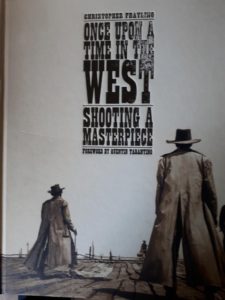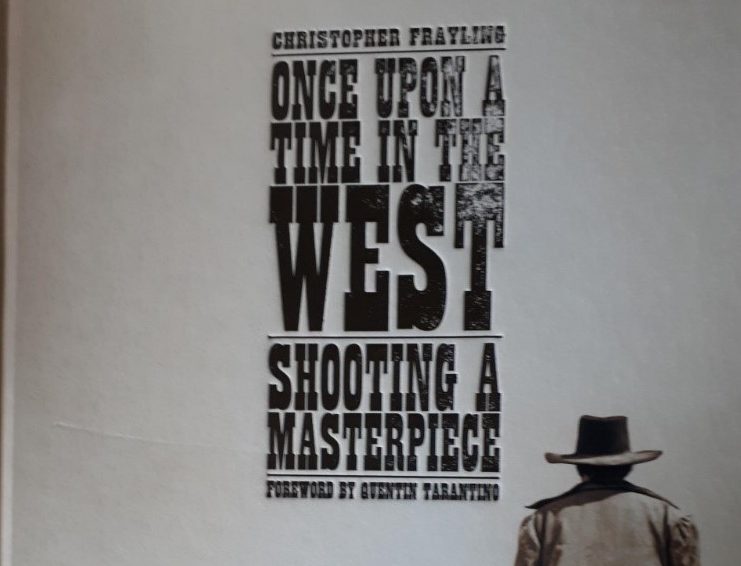25 April 2019
Once Upon A Time
in the West
by J.R. Thomas

 Enough! It is Easter, the spring is magnificently sprung, and we need a rest from all the nonsense which pervades the world of politics, and will no doubt continue far into the summer. Let us look back fifty years, to the time of Harold Wilson and Richard Nixon; and Charles De Gaulle. You see, nothing much really changes.
Enough! It is Easter, the spring is magnificently sprung, and we need a rest from all the nonsense which pervades the world of politics, and will no doubt continue far into the summer. Let us look back fifty years, to the time of Harold Wilson and Richard Nixon; and Charles De Gaulle. You see, nothing much really changes.
Fifty years ago saw the debut of one of the greatest films ever made, a film designed to let your popcorn crash unnoticed to the floor, your ice-cream to melt unhindered onto your Levi’s, a film that shocked America. Once Upon A Time In The West is the movie, Sergio Leone wrote and directed, Ennio Morricone composed and conducted the score, and the list of stars begins with Henry Fonda, Claudia Cardinale, Charles Bronson…
But first, a little movie history. Leone pioneered what we now call spaghetti westerns, powerful movies in the Western tradition, many starring Clint Eastwood, magnificently photographed and with Morricone’s music to etch them into your sub-conscious for all time. They are morality tales set in the frontier country, operas without arias for a new land. Leone was not making lightweight movies; he loved Westerns; he loved the American west and that part of American history, and was fascinated by the wild libertarian society of the border – and the blanket of civilisation that was soon drawn over it. And into that setting he was able to inject thoughts about the nature of humanity, the advance and regression of civilisation, of how men and women related to each other, and failed to relate to each other, and broader concepts such as the nature of justice and the quest for righteousness.
His movies, watchable at different levels, were commercially highly successful, making great profits for the studios, but as success does, spawning imitation upon imitation. A whole raft of western genre movies appeared, filmed, as Leone’s were, mostly in Italy and Spain, both for economy and for the easy access to suitable landscapes in which sets could be built. The imitations became almost unbearably bad – the advent of the Italian “actor” renamed Clint Westwood marked some sort of nadir – and Mr Leone vowed he would never make another Western. But even saying that, he knew he wanted to make one more, to pay tribute to both the Western, and to the West, a final Western movie that would hail farewell to the genre and leave nothing else to be said on the subject.
Once Upon A Time is that movie; what finally put Leone and his team back on set was securing Henry Fonda to star. Leone was a tremendous admirer of Fonda, but oddly, they had never met. Feelers were put out and the particular incentive offered to Fonda was that he was to be the villain of the film. Fonda was 63 and had never played a seriously villainous role, but here the villain was to be the core of the film. Eastwood, fearing being typecast, declined the role of Harmonica, which serendipitously led to Charles Bronson getting that role, a piece of luck which could not be bettered. Claudia Cardinale enrolled for the newly married Jill, and again it is difficult to think of an actress (oh, actor, if we must) who could have done it better. For minor and some quite major roles Leone cast a great number of older and often long retired cowboy and Western stars, another form of thanks to a genre he was about to leave for good.
On his first meeting with Fonda, Leone feared that he had made a terrible error. Fonda was old, and he had just come off a flight. Too old, too tired, shuffly and vague, thought Leone. He curtailed the conversation; but they met again the next day. Then it was a totally different Fonda – alert, trim, upright, and looking twenty years younger. The film was assured. (Fonda told a coda to this. On the first day of shooting in Rome he wore dark contact lens and had grown a huge moustache, to give a suitably evil appearance; he said that Leone’s first words were “Loose both”.)
If you are a devotee of this film you will not need any urging to see it again. If you last saw it long ago, then the time is upon you to see it again. And if you have never seen it, go and download it now. There will be no plot spoilers here in so far as they can be avoided, but it is a long movie – 165 minutes – so be prepared. Though you may be surprised how quickly it plays out.
The film was released a country at a time. In France and Germany it was a huge box office hit – indeed it remains the third highest grossing film ever in Germany. But in the US it was initially a disaster with the public. What seemed to happen that there were many folk who thought “Great, a proper Western, and what a cast. And Henry Fonda as star, yee-haw”. But Henry Fonda appearing out of the desert as villain? That could not be happening. We must not do plot spoilers, but when you watch it you will realise the point at which numbers of the great American public rose from their seats, gripped their pop-corn, and walked out in horror.
But once that shock was over, once the merits of the film were seen in context, the critics (most of them) had their admiring say, and the right target audience was identified (most of whom would never ordinarily watch a Western – until they realised that this film was far more than a cowboy movie); then it became recognised as a true masterpiece.
Its reputation has not just endured, it has grown and grown. Most Leone fans now cite it as his best movie, Fonda fans as his greatest piece of acting, and Morricone fans as his finest film score – which, given Morricone’s extraordinary talents, sets the bar high. It is readily available on DvD and on-line; it was hoped it might return to the big screen for a limited season but not much sign of that so far (email your local Odeon or Curzon manager). But do not despair, one of the film’s leading admirers is Christopher Frayling, former rector of the Royal College of Art and general highly distinguished arts person. His new book looks at every aspect of the movie, and is copiously illustrated with stills from both before and behind the camera. There is also a version of the film DvD which includes Sir Christopher narrating a back story to the film, with many interviews with stars – worth procuring for the Claudia Cardinale section alone.
When you stagger out of your darkened room, as the music breaks your heart, and you realise there can never be a more profound Western, our troubles of these days seem so trivial. Time to saddle the horse, sling your shotgun over your shoulder, kiss Cardinale or Cheyenne (do make your own selection) one last lingering time, and head West. There may not be much of it left, but there is enough to raise a cloud of dust in which to disappear.
* £50 (or less) hardback, published Reel Art Press 18th April 2019.


